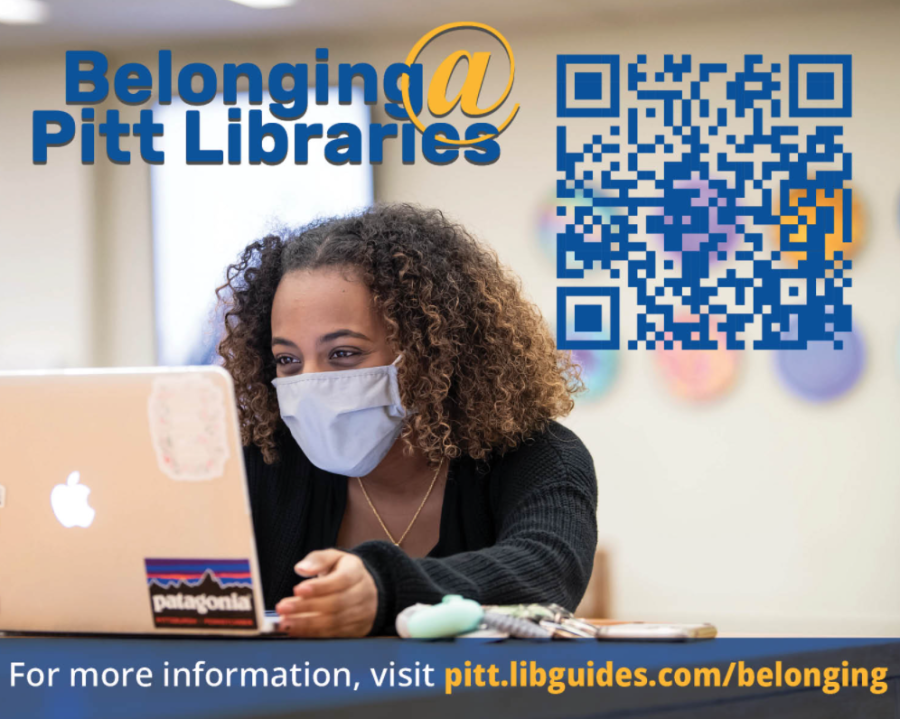Research project aims to create a feeling of belonging at Pitt libraries
February 18, 2022
Students use the library for a variety of reasons — to do homework, conduct research or just meet up with friends. Some librarians at Pitt, such as Rachel Rubin, often wonder how they can improve this multi-use space for students.
“Do students feel that they have an equal sense of belonging in the library, particularly in the physical space?” Rubin, an associate librarian for research and learning, questioned. “How do we make sure that all students, when they come into the library, feel like they belong?”
Questions such as these led a team of five Pitt librarians to create the Belonging at Pitt Libraries research project. The team — which includes Oakland librarians Rubin, Leslie Poljak, Berenika Webster and Diana Dill as well as Greensburg librarian Renee Kiner — enlists students to help improve Pitt’s libraries across the main and regional campuses and within different schools, such as the engineering library in Oakland.
Rubin said the objective of the project is to improve the physical curation of space as well as the library’s ability to support students as individuals in their academic success inside and outside of the classroom.
According to Poljak, the outreach and engagement librarian at Pitt’s Oakland campus, the team of librarians wanted to find a diverse group of students to participate in the project. She said they looked at student groups and organizations both on the Oakland campus and regional campuses to find participants.
“We had a few meetings about how we would find students that we were interested in [the project],” Poljak said. “We wanted to make sure we were getting diverse student voices as a part of this group and that we were finding students that were maybe students that use the library a lot or don’t use the library a lot so we could get a lot of different information.”
There are 20 students participating in the research project, who must attend one orientation session and one discussion group. Students can pick from three dates for an orientation session and three for a discussion group. According to the Library System website, the first orientation session option is February 22, and the first discussion group option is March 15.
Kiner, the public services librarian at Pitt’s Greensburg campus, said every regional campus except Titusville has students participating in the research project. Since students from multiple locations are participating, Rubin said all discussion groups will occur virtually.
To conduct the research, the student participants will use “photo voice,” a research method where pictures are the medium. According to Rubin, each student will take photos of public spaces, reflect on them individually, then discuss them in groups. While these pictures can be of places in the library, Rubin said they can be of any public spaces.
“Students will be taking pictures of public spaces in which they either feel like they belong or in which they don’t really feel like they belong,” Rubin said. “We’ll be bringing them together to give feedback on those photographs so they can collectively create pictures about what it is about a public space that makes them feel comfortable and what it is about a public space that makes them feel uncomfortable.”
Rubin said libraries are more than just a study spot for students, since they are specially positioned to not only provide students with curricular support but to also support students as “whole people.”
“One of the wonderful things about working in libraries on a campus is that we can basically be a room of requirement for students,” Rubin said. “Students can come and study alone, they can come and find resources, they can study in groups, or they can just escape. It’s not their dorm room, it’s not their work, it’s not a classroom.”
While Rubin said she doesn’t know what changes the research project will suggest to the library, she said she is interested in seeing what can be addressed right away and what can be addressed in the long term. She added that until the research is complete, it is unclear whether their findings will lead to structural changes to the Hillman library, which is currently under construction.
“One of the interesting things about research is that it’s hard to know what you are going to do with it until you get the results,” Rubin said. “It could be that the feedback we get is things that we can do with color, things that we could do with furniture, things that we could do with art, or, they could be hugely structural.”
Since Greensburg’s Millstein Library has not changed significantly since its construction, Kiner said she is looking forward to seeing what can be done to improve the library for students.
“Our campus library building is relatively new. It was built in 1994 but it hasn’t changed much since then,” Kiner said. “Since our student body changes, but the library itself hasn’t, I’m interested in hearing what the things are that we can do right away to foster belonging in the library. We are an undergraduate campus, so we want the students to come, feel welcomed, and stay.”
Rubin said this study is different from others, as it is about the way students feel in the library, and not just about how easy it is to use resources or access materials. She said “belonging” is an important feeling needed to foster diversity, equity and inclusion.
“We talk a lot about diversity, equity and inclusion. And I think belonging is the true fulfillment of that role,” Rubin said. “When you have ownership of the space and you feel a connection to the people in that space, you feel like you can be your whole self.”








